Brief Introduction To Thangka and Mandala Paintings
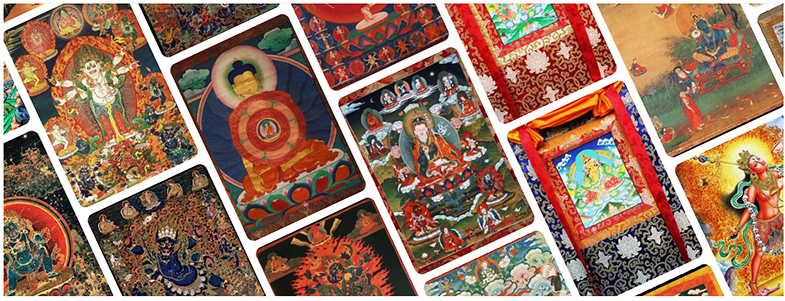
Thangka (also known as Pauva or Pauba पौभा in Nepali) is a painting usually illustrating a Buddist mandala or a deity. Unlike other painting, a thangka consists of picture painted or embroiled over a cotton cloth and then mounted on a silk frame cover. Although they are delicate in nature, these artworks last a very long time time and retain much of their lustre.
Thangkas served as important teaching and meditating tools. Most of the first artworks depicted the life of the Buddha, various influential lamas and the most relevant deities and bodhisattvas.
The most common subject depicted in the entry of Buddhist monasteries is “The Wheel of Life”, which is a diagram depiction of the Abhidharma teachings and the main concepts of Buddhist doctrine.
The paintings of Buddha Life were painted by lamas and monks in monasteries both in Tibet and Nepal. This knowledge was transmitted to members of the monks families and then spread among lay people and devotees that started thangka art painting schools, especially in the Kathmandu valley.
A thangka painting can be considered as an object of decoration, but its spiritual importance is more relevant, especially for Buddhist monks and scholars who revere it with mystic power accordingly to the deities represented.
Devotional images act as the centerpiece during a ritual or ceremony and are often used as mediums through which one can offer prayers or make requests. Overall, and perhaps most importantly, religious art is used as a meditation tool to help bring one further down the path to enlightenment.
Images of deities can be used as teaching tools when depicting the life (or lives) of the Buddha, describing historical events concerning important Lamas, or retelling myths associated with other deities.
History of Thangka in Nepal
Thangka is a Nepalese art form exported to Tibet after Princess Bhrikuti of Nepal, daughter of King Lichchavi, married Songtsän Gampo, the ruler of Tibet and thus imported the images of Nepalese deities to Tibet. History of thangka Paintings in Nepal began in 11th century A.D. when Buddhists and Hindus began to make illustration of the deities and natural scenes.
Historically, Tibetan and Chinese influence in Nepalese paintings is quite evident in Thangkas.
It was through Nepal that Mahayana Buddhism was introduced into Tibet during reign of Angshuvarma in the seventh century A.D. There was therefore a great demand for religious icons and Buddhist manuscripts for newly built monasteries throughout Tibet.
A number of Buddhist manuscripts were copied in Kathmandu Valley for these monasteries.
The influence of Nepalese art extended till Tibet and even beyond in China in regular order during the thirteenth century. Nepalese artisans were dispatched to the courts of Chinese emperors at their request to perform their workmanship and impart expert knowledge. The exemplary contribution made by the artisans of Nepal, specially by the Nepalese innovator and architect Araniko, bear testimony to this fact even today.
From the fifteenth century onwards, brighter colours gradually began to appear in Nepalese Thangka. Because of the growing importance of the Tantric cult, various aspects of Shiva and Shakti were painted in conventional poses. Mahakala, Manjushri, White Tara, Chenrezig and other deities were equally popular and so were also frequently represented in Thanka / Thangka paintings of later dates.
As Tantrism embodies the ideas of esoteric power, magic forces, and a great variety of symbols, strong emphasis is laid on the female element and sexuality in the representation of Dakinis and female Goddesses.
Realizing the great demand for religious icons in Tibet, Nepalese artists, along with monks and traders, took with them from Nepal not only metal sculptures but also a number of Buddhist manuscripts. To better fulfill the ever – increasing demand Nepalese artists initiated a new type of religious painting on cloth that could be easily rolled up and carried along with them.
This type of painting became very popular both in Nepal and Tibet and so a new schools of thangka painting evolved as early as the ninth or tenth century and has remained popular to this day.
One of the earliest specimens of Nepalese thangkas dates from the thirteenth century and shows Buddha Amitabha surrounded by Bodhisattva. The Mandala of Vishnu dated 1420 A.D., is another fine example of the painting of this period.
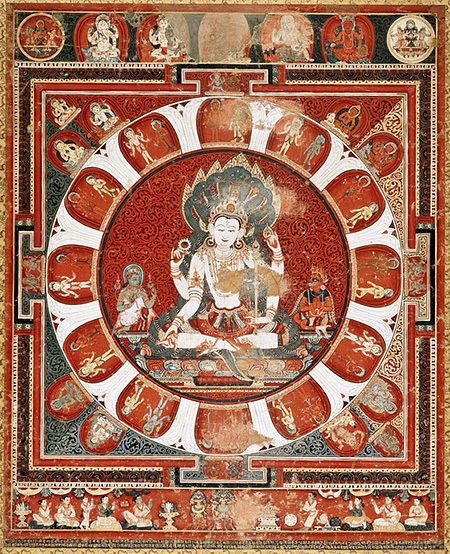
Early Nepalese Thangkas are simple in design and composition. The main deity, a large figure, occupies the central position while surrounded by smaller figures of lesser divinities.
During the reign of Tibetan Dharma King Trisong Duetsen the Tibetan masters refined their already well developed arts through research and studies of different country’s tradition.
Thanka painting’s lining and measurement, costumes, implementations and ornaments are mostly based on Indian styles. The drawing of figures are based on Nepalese style and the background landscapes are based on Chinese style.
Thus, Thangka paintings became a unique and distinctive art.
Thangkas are produced mostly in the northern Himalayan regions among the Newari, Lamas, Gurung and Tamang communities.
Entire families belonging to these communities have preserved this art for generations, which provide today substantial employment opportunities for many people.
How To Order
- Browse our catalog and choose your favorite design.
- Select your preferred size and quality to check the price.
- Click on “Product Inquiry” to send us a message and we will check if we the artwork is immediately available. If not we will make it for you.
- Use the cart page to calculate the shipping cost by selecting your country.
- Once we receive your order we will start creating the artwork according to your preferences and provide you with updates and images upon your request.
We strive to ensure a smooth shopping experience with our assistance. We also welcome commissions of custom designs of thangkas, masks and mandalas.
Shipping and Payments
We offer trusted shipping options to ensure your purchases arrive in perfect condition, and delivered in 5 to 10 working days worldwide. We accept PayPal, debit/credit cards and bank wire transfer services.
About Our Community
We live in Changunarayan, a UNESCO heritage site located on a forested hill overlooking Bhaktapur and the Kathmandu valley. You are welcome to visit our art school and meet our community of artists and artisans.
Learn More About Our Thangka School And Workshops
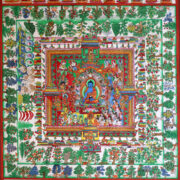 Medicine Buddha Paradise
Medicine Buddha Paradise 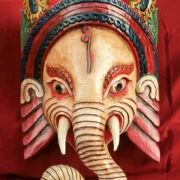 Ganesh Mask Design #01
Ganesh Mask Design #01 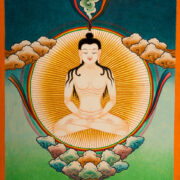 Tapihritsa Bon Yogi
Tapihritsa Bon Yogi 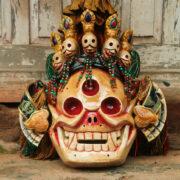 Citipati Mask
Citipati Mask 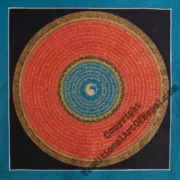 Triple Yin-Yang Mandala
Triple Yin-Yang Mandala  Universe Om Mandala
Universe Om Mandala 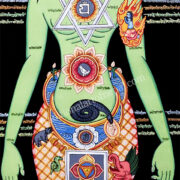 Chakraman Yogi
Chakraman Yogi 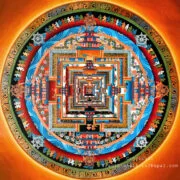 Kalachakra Mandala
Kalachakra Mandala 
Leave a Reply
You must be logged in to post a comment.